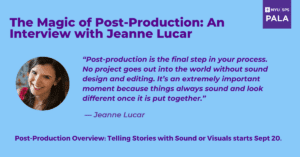How do you transform raw footage or audio into a finalized project? Post-production is a critical step in the creative process. NYU SPS PALA is offering a course that will allow you to excel in in this field: Post-Production Overview: Telling Stories With Sound Or Visuals. This class will be taught by Jeanne Lucar, a Grammy-nominated audio engineer and radio producer. We talked to Lucar about what students can expect from this course and why post-production is important.
What can students expect from the Post-Production Overview: Telling Stories With Sound Or Visuals course?
JL: Students should expect to get a good handle on several different concepts, so that they can individually take a project through to the end. Nowadays, so many job posts expect you to know how to do 4 different jobs. It doesn’t make it right, but it’s the reality of today’s career market. Students will go through post for audio and video as well as the editorial process so students can actually offer many different skills. We will cover sound design, some video editing, and great ways to edit yourself.
What is typically involved in the post-production process for a sound or video project?
JL: In the post production process, students will more than likely have their interviews completed and potentially have ideas for how they want to tell the stories. Post production entails creating outlines, selecting the audio or video you want to use, and creating a script. Once we have those pieces, the editing timeline can be assembled whether it’s video or audio. Taking that first assembly to a finalized product is an exciting time as the student’s will get to hear and see their vision come to life.
Why is post-production a critical step in realizing a media project?
JL: Post-production is the final step in your process. No project goes out into the world without sound design and editing. It’s an extremely important moment because things always sound and look different once it is put together. That means occasionally things won’t actually work and need to be workshopped or restructured. In order for the piece to be the best it’s going to be, it needs to go through a series of edits and this has to happen in post-production.
Can you describe a project you were involved in that was transformed by the post-production process?
JL: The first time you see or hear your project come together is an amazing moment. I was assembling an episode of Loud: The History of Reggaeton, and it was clear to me that the opening wasn’t working. The first few minutes of anything are crucial because if it’s not engaging, people will turn it off. I went back to the producers and let them know a few options that might work, we brainstormed together, and the opening was restructured. A lot of times, things work on paper that don’t work when you listen or see it.
What do you expect to find most rewarding about teaching this course?
JL: I’m excited to see students learn how to do as much as they can on their own. Being able to wear a lot of hats has been an asset for myself as a producer. I’m always impressed by the creativity students bring to the table, and I look forward to seeing how all that unfolds. The biggest reward for me is to see them excel.
Post-Production Overview: Telling Stories with Sound or Visuals starts September 20. Register today here.
